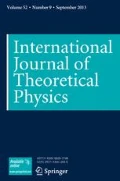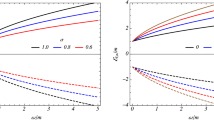Abstract
We consider a model for an underpinning of the universe: there are oscillators at the Planck scale in the background dark energy. Starting from a coherent array of such oscillators it is possible to get a description from elementary particles to Black Holes including the usual Hawking-Beckenstein theory. There is also a description of Gravitation in the above model which points to a unified description with electromagnetism.
Similar content being viewed by others
References
Kiefer, C.: Quantum Gravity. Clarendon, Oxford (2004)
Regge, T., de Alfaro, V.: Potential Scattering. North Holland, Amsterdam (1965)
Roman, P.: Advanced Quantum Theory, p. 31. Addison-Wesley, Reading (1965)
Bogdan, P., Rith, K.: Particles and Nuclei: An Introduction to the Physical Concepts. Springer, Berlin (1993)
Veneziano, G.: In: Huggett, S.A., et al. (eds.) The Geometric Universe. Oxford University Press, Oxford (1998)
Veneziano, G.: Phys. Rep. 9(4), 199–242 (1974)
Lee, T.D.: Particle Physics and Introduction to Field Theory. Harwood Academic, Reading (1981)
Martin, B.R., Shaw, G.: Particle Physics. Wiley, New York (1992)
Sidharth, B.G.: Fuzzy, non commutative spacetime: a new paradigm for a new century. In: Sidharth, B.G., Altaisky, M.V. (eds.) Proceedings of Fourth International Symposium on “Frontiers of Fundamental Physics, pp. 97–108. Kluwer Academic/Plenum, New York (2001)
Fogleman, G.: Am. J. Phys. 55(4), 330–336 (1987)
Schwarz, J.: Physics Reports 89(227) (1982)
Jacob, M. (ed.) Physics Reports. North-Holland, Amsterdam (1974) reprint volume
Veneziano, G.: Quantum geometric origin of all forces in string theory. In: Huggett, S.A., et al. (eds.) The Geometric Universe, pp. 235–243. Oxford University Press, Oxford (1988)
Ramond, P.: Phys. Rev. D 3(10), 2415–2418 (1971)
Kaluza, Th.: An Introduction to Kaluza-Klein Theories. Singapore, World Scientific (1984)
Greene, B.: The Elegant Universe, p. 15. Vintage, London (1999)
Madore, J.: An Introduction to Non-Commutative Differential Geometry. Cambridge University Press, Cambridge (1995)
Laughlin, R.B.: A Different Universe. Basic Books, New York (2005)
Smolin, L.: The Trouble with Physics. Houghton Mifflin Company, New York (2006)
Sidharth, B.G.: When the Universe Took a U Turn. Singapore, World Scientific (2009)
Susskind, L.: The Black Hole War. Back Bay Books, New York (2008)
Sidharth, B.G.: Thermodynamic Universe. Singapore, World Scientific (2008)
Sidharth, B.G.: Chaotic Universe: From the Planck to the Hubble Scale. Nova Science, New York (2001)
Sidharth, B.G.: The Universe of Fluctuations. Springer, Netherlands (2005)
Sidharth, B.G.: Found. Phys. Lett. 17(5), 503–506 (2004)
Sidharth, B.G.: Found. Phys. Lett. 15(6), 577–583 (2002)
Goodstein, D.L.: States of Matter. Dover, New York (1975)
Jack Ng, Y., Van Dam, H.: Mod. Phys. Lett. A 9(4), 335–340 (1994)
Rosen, N.: Int. J. Theor. Phys. 32(8), 1435–1440 (1993)
Sidharth, B.G.: Int. J. Mod. Phys. A 21(31), 6315 (2006)
Sidharth, B.G.: Int. J. Theor. Phys. 48(12), 3421 (2009)
Cercignani, C.: Found. Phys. Lett. 11(2), 189–199 (1998)
Sakharov, A.D.: Sov. Phys. Dokl. 12(11), 1040–1041 (1968)
Sidharth, B.G.: Int. J. Theor. Phys. 48(8), 2427–2431 (2009)
Ruffini, R., Zang, L.Z.: Basic Concepts in Relativistic Astrophysics. Singapore, World Scientific (1983)
Baez, J.: Nature 421, 702–703 (2003)
Sidharth, B.G.: In: Hartnett, J., et al. (eds.) Alternative Routes to Gravitation in Frontiers of Fundamental Physics. AIP, New York (2010)
Sidharth, B.G.: Energy and mass generation. arXiv:1003.2330
Author information
Authors and Affiliations
Corresponding author
Additional information
Based on the Paper at the Max Born Symposium, 2009, Wroclaw.
Rights and permissions
About this article
Cite this article
Sidharth, B.G. Planck Oscillators in the Background Dark Energy. Int J Theor Phys 49, 2476–2485 (2010). https://doi.org/10.1007/s10773-010-0433-z
Received:
Accepted:
Published:
Issue Date:
DOI: https://doi.org/10.1007/s10773-010-0433-z



